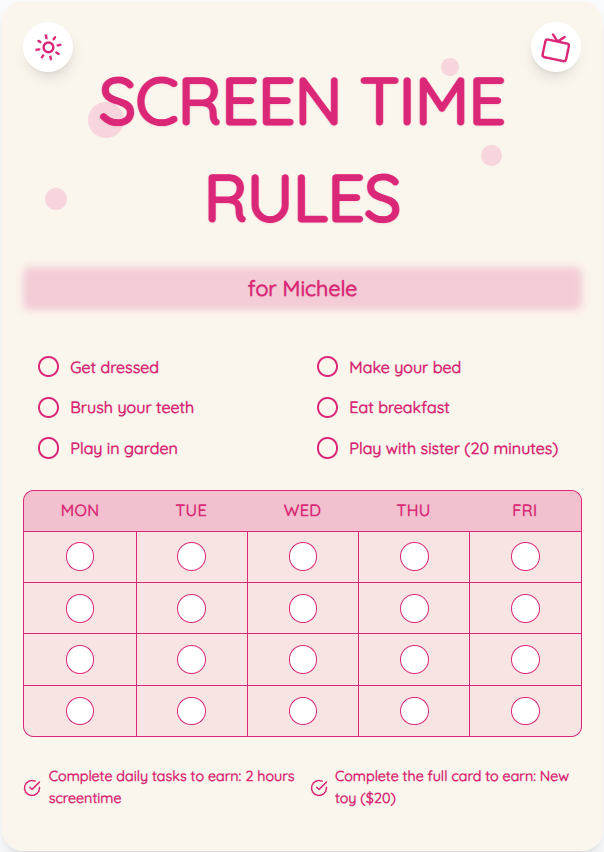When Should Kids Have Screen Time? A Parent's Guide to Finding Balance
As a parent, navigating the world of screen time for your children can be challenging. Finding the right balance between technology use and other activities is crucial for their development. In this guide, we'll explore when kids should have screen time and provide practical tips to help you manage it effectively.
See What Your Screen Time Chart Will Look Like
Here's an example of a beautiful, customizable screen time rules chart you can create for your family

Understanding Screen Time Guidelines
Screen time guidelines vary depending on the age of the child. The American Academy of Pediatrics recommends no screen time for children under 18 months except video chatting. For toddlers aged 18-24 months, limited high-quality programming is appropriate. Preschoolers aged 2-5 years should have no more than one hour of screen time per day of high-quality programming. For children aged 6 and older, consistent limits on screen time should be established. Understanding these guidelines is essential for setting appropriate boundaries.
Factors to Consider When Setting Screen Time Limits
When determining when kids should have screen time, consider factors such as the content they are consuming, the impact on their sleep, physical activity levels, and social interactions. It's important to prioritize activities like outdoor play, reading, and creative play alongside screen time. Observe your child's behavior and mood to gauge if screen time is affecting them positively or negatively.
Put These Tips Into Action
Create a custom chart to implement these strategies with your child
Practical Tips for Managing Screen Time
1. Create a screen time schedule and stick to it. 2. Use screen time charts to visually represent limits. 3. Encourage alternative activities like arts and crafts, sports, or board games. 4. Set a good example by limiting your own screen time. 5. Establish tech-free zones in the house, such as the dining area or bedrooms. 6. Engage with your child during screen time to make it interactive and educational.
Practical Tips for Success
- Set clear boundaries and rules around screen time.
- Encourage outdoor play and physical activities.
- Monitor the content your child is viewing.
- Use positive reinforcement to reward healthy screen time habits.
Frequently Asked Questions
Is all screen time harmful for kids?
Not all screen time is harmful. The key is to monitor the quality of content, set limits, and ensure a balance with other activities.
How can I create a screen time chart for my child?
You can use online tools like ScreenTimeRules.com to generate personalized screen time charts based on your child's age and daily routine.
What are the signs that my child is spending too much time on screens?
Signs include irritability when screen time is interrupted, neglecting other activities, and changes in sleep patterns. It's important to address these signs promptly.
Finding the right balance with screen time for your kids is a journey that involves trial and error. By following these practical tips and staying attuned to your child's needs, you can create a healthy approach to technology use in your household. Remember, setting limits early on can foster positive habits that benefit your child's overall well-being.
Ready to Transform Your Family's Screen Time?
Join thousands of parents who have successfully managed screen time with our customizable charts.
